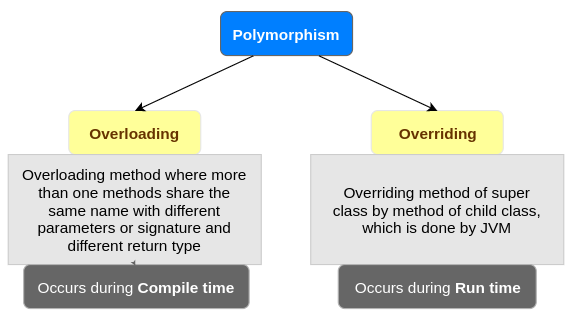In this tutorial, you will learn about Polymorphism in Java, and what overloading and overriding mean, with examples.
Polymorphism in Java
In Greek language, Poly means many and morphs means forms. Therefore Polymorphism translates to many forms. Precisely, Polymorphism is a condition of occurring in several different forms. Polymorphism in Java can occur in two ways:
- Overloading
- Overriding
Following picture gives a basic difference between overloading and overriding in Java.

You may refer Method Overloading in Java to understand what Overloading is in detail.
You may also refer Method Overriding in Java to understand what Overriding is in detail.
Differences between Overloading and Overriding
Following table helps you find the differentiation between Overloading and Overriding mechanisms in Java. The first column contains a parameter on which we differentiate overloading and overriding.
| Parameter | Overloading | Overriding |
| Resolved by | Compiler | JVM (Java Virtual Machine) |
| Resolved during | Compile time | Run time |
| Is achieved by | function overloading or parameter overloading | virtual methods and references to object instances |
| Effect on execution time | Fast (’cause, its done at compile time only once) | Slow (’cause its done at runtime whenever overriding happens) |
| Other names | Early binding (or) Static binding | Late binding (or) Dynamic binding |
Let us see how overloading and overriding works, with the help of following examples.
Examples
1. Overloading
In this example, we have two methods, with same name printer, but with different set of parameters. First printer() method accepts two String arguments while second printer() accepts only one String argument. In the main() method, we are calling printer() method with different number of arguments. During compilation, compiler resolves the method to be called, based on the number of arguments we are passing.
Messenger.java
package com.tutorialkart.java;
/**
* @author tutorialkart
*/
public class Messenger {
public static void main(String[] args) {
Messenger msngr = new Messenger();
msngr.printer("Bring me two trays of eggs.", "Room-mate");
msngr.printer("Good Morning India.");
}
public void printer(String message,String sender){
System.out.println(sender + " : " + message);
}
public void printer(String message){
System.out.println("Broadcast message : " + message);
}
}Run the above Java program. Output to the console should be as shown below.
Room-mate : Bring me two trays of eggs.
Broadcast message : Good Morning India.2. Overriding
In this example, we have super class Car.java with method run(). And there is a child class Jaguar.java with method run(). When an object of type Car is created with reference to Jaguar (Car c = new Jaguar();), invoking run method on object “c”, would execute run method in Jaguar. All this is done during run time.
OverridingExample.java
package com.tutorialkart.java;
/**
* @author tutorialkart
*/
class Car{
public void run(){
System.out.println("Car is running.");
}
}
class Jaguar extends Car{
public void run(){
System.out.println("Jaguar is running.");
}
}
public class OverridingExample {
public static void main(String[] args) {
Car c = new Jaguar();
c.run();
}
}
Run the above program and you shall get the output to the console as shown below.
Jaguar is running.Conclusion
In this Java Tutorial, we learned the two different ways of Polymorphism in Java: method overloading and method overriding. We went through many examples to understand Polymorphism in Java.
In our next tutorial, we shall go through Method Overloading in detail.
